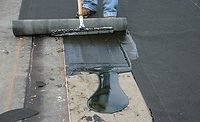Just as the Center has spent considerable time and resources to improve rooftop PV solar installations, we are also interested in other technologies that harness the power of the sun falling on our rooftops. These technologies include rooftop solar thermal, which offers an economical source of hot water for buildings, and roof daylighting, which can supplement a considerable amount of a building’s artificial lighting needs. When properly designed and installed, these technologies offer excellent return on investment for building owners as well as increased sales and profits for roofing contractors.
In addition to offering solid financial rewards, solar thermal and roof daylighting are compatible not only with each other but also with rooftop PV systems. That means building designers and owners can use all of these technologies to maximize the production of sustainable rooftop energy.
One of the best examples of the “all-of-the-above” approach to rooftop energy is the Headquarters Honda roof in Clermont, Fla. Installed by Tecta America South Florida, the roof on this innovative auto dealership features a 126 KW PV system generating a large percentage of the building’s power needs, a 55-square-foot solar thermal collector that supplies all hot water for the building, and roof skylights over the service bays integrated with the lighting controls to minimize artificial lighting needs. In addition, the Headquarters Honda roof features high-R insulation levels and a cool reflective surface to reduce the total energy needs of the facility.
Undoubtedly the most challenging aspect of the project was making sure that the solar and daylighting layouts were properly arranged so that all of the technologies were installed without significant shade obstructions. This was a difficult task as it required careful assessment of the ensuring that the field conditions would work with the design plan. Because a comprehensive solar strategy requires careful design to assure optimal performance, I will spend more time in future columns to discuss the resources and tools needed to make the best of each of these high-energy, high-payback rooftop solar solutions. Next month, we’ll start by taking a closer look at modern daylighting technologies and how these technologies can be engineered to provide the best overall energy payback.
But until next month, please consider rooftop solar energy as an “all-of-the-above” opportunity for added value and profit.






Report Abusive Comment